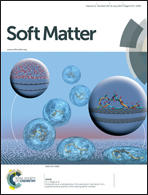Preparation of upper critical solution temperature (UCST) responsive diblock copolymers bearing pendant ureido groups and their micelle formation behavior in water†
Abstract
Poly(2-ureidoethyl methacrylate) (PUEM) was prepared via reversible addition–fragmentation chain transfer (RAFT) controlled radical polymerization and a post-modification reaction. PUEM shows upper critical solution temperature (UCST) behavior in aqueous solution. Although PUEM can dissolve in water above the UCST, it cannot dissolve in water below the UCST. Diblock copolymers (MmUn) composed of a biocompatible hydrophilic poly(2-methacryloyloxyethyl phosphorylcholine) (PMPC) block and a PUEM block with different compositions were prepared via RAFT radical polymerization and a post-modification reaction. “M” and “U” represent PMPC and PUEM blocks, respectively, and the subscripts represent the degree of polymerization of each block. M95U149 and M20U163 formed polymer micelles comprising a PUEM core and a PMPC shell below the critical aggregation temperature (Tc) in aqueous solution. Polymer micelles were formed from M20U163 below 32 °C, which can incorporate guest molecules into the core.


 Please wait while we load your content...
Please wait while we load your content...